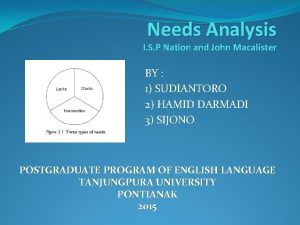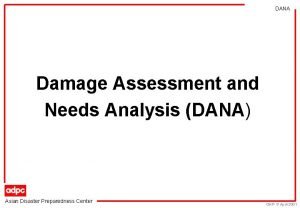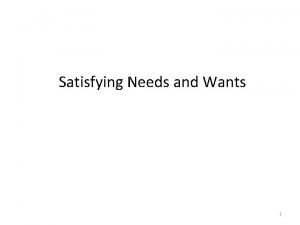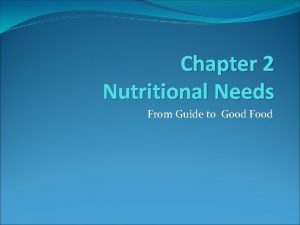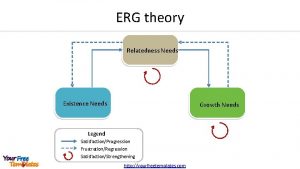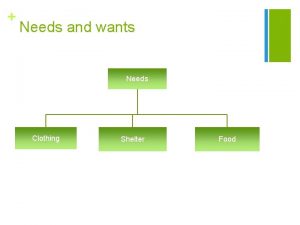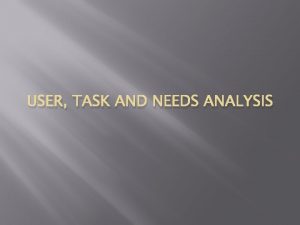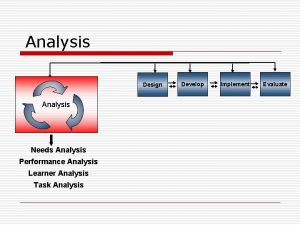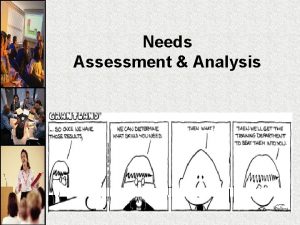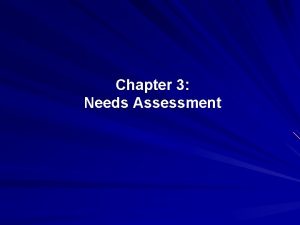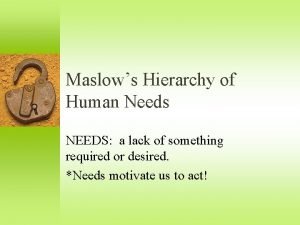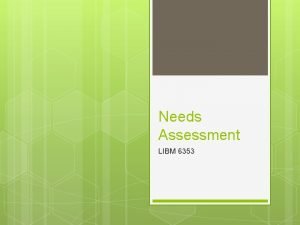CHAPTER 3 NEEDS ANALYSIS Needs analysis l It















- Slides: 15

CHAPTER 3 NEEDS ANALYSIS

Needs analysis l It examines what the learners know already and what they need to know l Hutchinson and Waters (1987) divide needs into target needs (i. e. what the learner needs to do in the target situation) and learning needs (i. e. what the learner needs to do in order to learn). 1 - Necessities What is necessary in the learners’ use of language? i. e do the learners have to write answers to exam questions 2 - Lacks What do the learners lack? For example, are there aspects of writing that were not practiced in their previous learning (L 1, L 2)? 3 - Wants What do the learners wish to learn?

Needs analysis objective needs can be gathered ü by questionnaires, ü personal interviews, ü data collection (for example, gathering exam papers ü or text books and analysing them), ü observation (for example, following a learner through a typical day), ü informal consultation with teachers and learners, and tests. Subjective needs are discovered through ü learner self assessment using lists and scales, and questionnaires and interviews

Goals Questions Types of information in the answers Language ❶ What will the course be used for? ❷ How proficient does the user have to be? ❸ What communicative activities will the learner take part in? ❹ Where will the language be used? ►Sounds ►Vocabulary ►Grammatical structures ►Functions ►Set phrases and set sentences ►Tasks Questions for focusing on needs Ideas ❶ What content matter will the learner be working with? Skills ❶ How will the learner use the language? ►Listening ❷ Under what conditions will the language be used? ►speaking ►Reading ❸ Who will the learners use the language with? ►Writing ►Degree of accuracy ►Degree of fluency Texts ❶ What will the language be used to do? ❷ What language uses is the learner already familiar with? ►Topics ►Themes ►Texts ►genres and discourse types ►sociolinguistic skills Genre: a category of artistic, musical, or literary composition that is characterized by a particular style, form, or content. Discourse: the use of words to exchange thoughts and ideas: a long talk or piece of writing about a subject.

Needs analysis- DISVOVERING NEEDS • Organized around necessities, lacks and wants. • Proficiency relates to present knowledge and situations of use and involves the study of situations and tasks that learners will need to engage in using knowledge gained from the course.

Needs analysis- DISVOVERING NEEDS Self-report involves ü written responses to a structured set of questions or to a sentence completion task. ü diary writing or some other form of extended written report. ü group activities such as voting, ranking, brainstorming, or problem solving.

Needs analysis- DISVOVERING NEEDS Observation and analysis may involve process and product. Observation of skilled and unskilled writers performing target tasks may reveal important areas that need attention during a course.

Needs analysis-Necessities (English for academic purposes as an example) The first thing to look at in necessities is the demands of the target tasks. That is, what will learners have to do when they do university study? Among the things they will have to do is: To listen to lectures, To take part in tutorials, To write assignments and tasks, and To sit exams.

Needs analysis- Necessities l assignments as one example of the things they have to do, we could analyze the kind of language needed to do an assignment as a way of working out what the learners would need to know. 1. We could do this by doing a vocabulary analysis of good assignments, using a program like the Frequency programme. -Is it necessary to have a large vocabulary to write a good assignment, or can an assignment be well written in a limited vocabulary? ) 2. look at past assignment topics to see the kinds of discourse that learners would have to handle. -Are the assignments mainly descriptions, analyses, comparisons, persuasive pieces of writing or instructions? -We could interview university staff who are involved in setting and marking such assignments to see what they expect in a good assignment 3. look in course outlines and other departmental information to see if there any guidelines on writing assignments. -If we have access to assignments from successful students in previous years, these could be a useful source of information. 4. We could also look at the timeframe involved in writing an assignment. -Do the learners have time to prepare notes, a rough draft, and a further draft? -If they know the assignment topics well before the assignment is due, then the English for academic purposes course could focus more strongly on the process of assignment writing.

Needs Analysis- Lacks An important part of needs analysis involves looking at where learners are at present. (How good are the learners at writing assignments now? ) ü The assignment can be analyzed from an information perspective, from a grammar perspective and from the discourse perspective ü look at an assignment to look at the parts of the writing process and to see what degree of skill in each part is reflected in the assignment. ü look at the learners in the process of writing an assignment. The quality of an assignment often depends on the conditions under which it was written. ü Another source of information about lacks could come from the university lecturer who marks such assignments. What do they see as the strengths and weaknesses of the assignment that the learner has written?

Needs Analysis- Lacks l The learners themselves. How does the learner interpret the assignment task? Interview is a good way l To gather data about the learners’ general proficiency, we can interview them, we can get them to do self-assessment using a specially prepared checklist. Learners’ scores on standardised proficiency tests like the TOEFL test or the IELTS test can be a very useful source of information particularly when they provide information about separate aspects of language proficiency such as writing or speaking.

Needs Analysis- Wants l Learners have their own views about what they think is useful for them. the learners’ views and the needs analyst’s views are to be the same l If they are then rethink the results of the analysis or convince the learners l Learners can be asked what they think will improve their assignment writing and what they want to be able to do regarding assignment writing Need Analysis tools include • • • text analysis, talking with students both past and present, surveying the environment, looking at pieces of work, talking with teachers, employers and assessors, and using experience and commonsense. personal

Needs Analysis- Wants Needs should be looked at according to the type of need lack = present knowledge, Necessities= required knowledge wants= subjective needs, and objective needs the source of information ü present learners, ü past learners, ü teachers, ü present tasks and materials, ü future colleagues or future assessors or teachers, the data-gathering tools ü text and discourse analysis, ü frequency counts, ü interviews, ü questionnaires, ü observation, ü negotiation and discussion, reflection on experience, type of information ü learning goals, ü preferred styles of learning, ü learners’ commitment to learning.

Evaluating Needs Analysis Reliability ü ü ü using well-thought-out, standardized tools that are applied systematically. systematize the observation by using a checklist, or by recording and apply standardized analysis procedures. The more pieces of observation and the more people who are studied, the more reliable the results. Validity ü ü ü looks at what is relevant and important. type of need that and the type of information that is being gathered is important. Before needs analysis begins it may be necessary to do a ranking activity. Practicality

Tasks Task 1 Needs analysis for a writing course (page, l Task 2 Evaluating a needs analysis scheme l Task 3 Discovering needs (pages, 33 -34 -35) l 2 Case Studies will be delivered, -situational analysis -needs analysis l
 Primary needs and secondary needs
Primary needs and secondary needs Primary needs and secondary needs
Primary needs and secondary needs Henry murray theory
Henry murray theory Strategic gender needs and practical gender needs
Strategic gender needs and practical gender needs Types of needs analysis in esp
Types of needs analysis in esp Wants analysis
Wants analysis Needs analysis necessities lacks wants
Needs analysis necessities lacks wants Needs analysis esl
Needs analysis esl Dana asian
Dana asian Training cycle steps
Training cycle steps Individual needs analysis
Individual needs analysis Satisfying needs parte 1
Satisfying needs parte 1 Entrepreneurs satisfy needs and wants
Entrepreneurs satisfy needs and wants Cna chapter 8 human needs and human development
Cna chapter 8 human needs and human development Diversity and human needs and development
Diversity and human needs and development Chapter 2 nutritional needs
Chapter 2 nutritional needs






